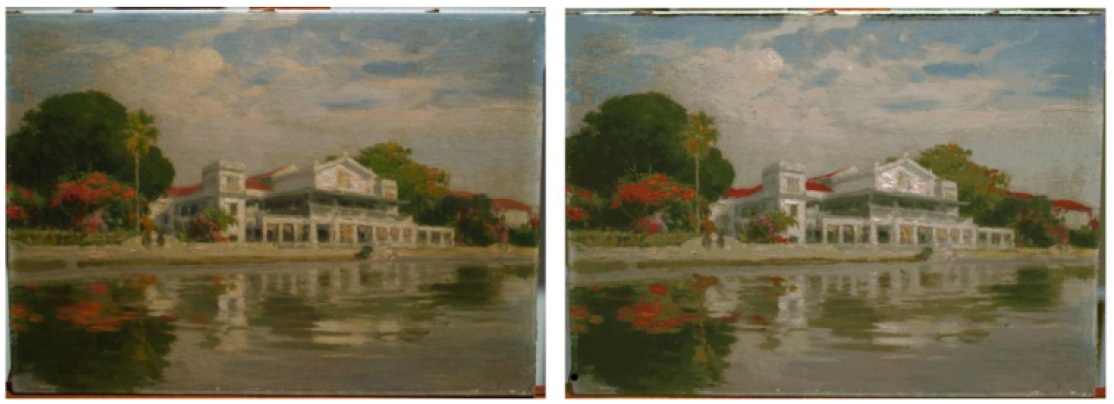
The painting “Malacañang by the River” by the Philippines’ painter Fernando Amorsolo, before and after digital restoration. (c) Optical Express / Optical Society of America
The restoration of oil paintings is always a delicate process. Decades and centuries of dust and grime on the surface of a painting are difficult to remove, as the dirt sticks firmly to the painting’s oil paints and varnish. There is always the danger that a thorough physical cleaning and restoration may alter a painting’s original appearance.
A solution to restore a painting without touching it is to do it in the computer, which has the advantage that you can see the likely original state of a painting without restoration and its potentially damaging consequences. The problem here is that for digital restoration a reference is needed how the painting and the colours looked in their original state. This typically means that a small part of the painting has to be cleaned for real, or that some of the paint pigments are sampled from the painting and analysed. None of this is a good solution, as again they might affect the painting.
Cherry May T. Palomero and Maricor N. Soriano from the University of the Philippines have now developed an improved digital restoration technique based on a neural network algorithm. They took a 1948 painting by Fernando Amorsolo and took it out of its original frame. The sections of the painting that were covered by the wooden frame were less dirty than the exposed sections of the painting, and the researchers used these to train their neural network algorithm to clean up the painting.
The performance of the algorithm then needs to be checked for accuracy. For this, obvious facts such as that usually you would expect the sky in a painting to become more blue were used. And perhaps more relevant, the transition from the cleaner border of the painting to the main part should not be visible anymore once the algorithm is applied.
Nevertheless, an issue of using such computer algorithms is that they have a tendency to overdo it, with detrimental consequences. It is as if you crank up the contrast in a digital image manipulation and as a consequence important details of the painting are lost. To avoid this, Palomero anad Soriano record the colour distribution of specific sections of a painting before and after cleaning. If for some of the pixels the average colour distribution gets too distorted by the cleaning, then the process is reverted back for those pixels with the most extreme change in colour.
The result is a painting that certainly looks much cleaner and with more vibrant colours than the unrestored original. This way, the original painting can be enjoyed in all its splendour. And what’s more, should there ever be an actual restoration of the painting, then this digitally cleaned painting could serve as a template for the physical cleaning process.
Reference: (the paper is open access, so why not have a look)
Palomero, C., & Soriano, M. (2011). Digital cleaning and “dirt” layer visualization of an oil painting Optics Express, 19 (21) DOI: 10.1364/OE.19.021011



October 24, 2011
1 Comment